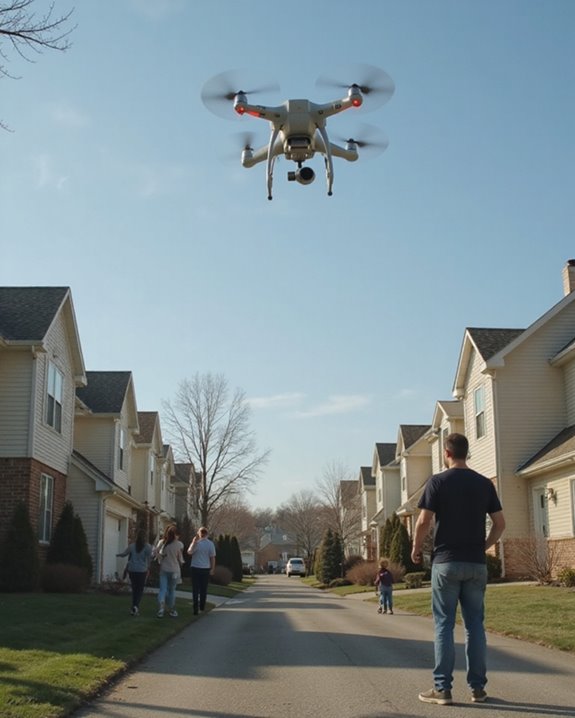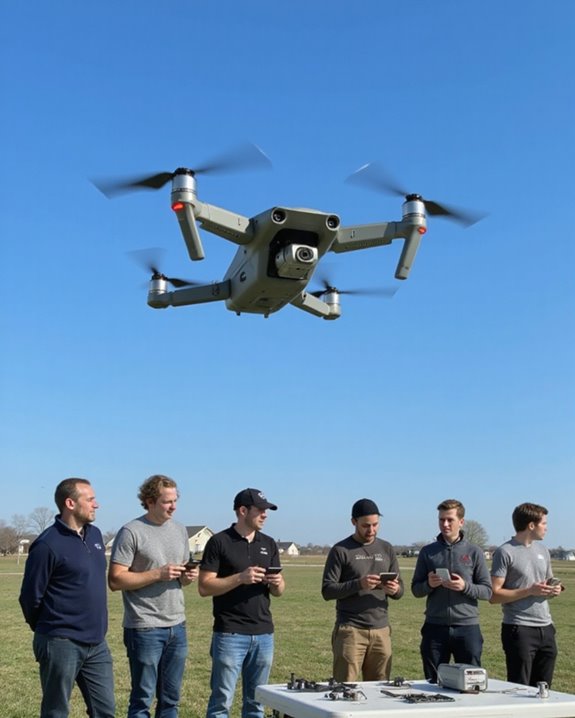Marine drones—think robot submarines and flying spy-bots—are reshaping the oceans! These clever machines use sensors, smart AI, and tough shape-shifting shells to patrol for pirates, track fish, and even sniff out pollution. From mapping seafloors with laser eyes to joining forces in drone swarms (it’s like synchronized swimming, but way geekier), marine drones boost security, rescue missions, and environmental studies. As tech evolves, the benefits keep growing—so stick around for more surprising insights!
Key Takeaways
- Marine drones include airborne, surface, and underwater vehicles equipped with advanced sensors and autonomous features for versatile ocean missions.
- They are widely used in maritime surveillance, environmental monitoring, resource exploration, and emergency response operations.
- Technological advancements like AI, smart sensors, and tougher materials have made marine drones smarter, more resilient, and capable of deep-sea exploration.
- Drones enhance maritime security by detecting piracy, smuggling, and suspicious activities using coordinated swarm technology and real-time data analysis.
- Strict regulations and ethical frameworks guide safe, responsible drone use, ensuring protection of ocean environments and operator training.
Defining Marine Drones and Their Main Types
When you hear the term “marine drones,” you might imagine futuristic gadgets skimming across the ocean or diving deep beneath the waves—and honestly, you’re not far off! In Drone Terminology, “marine drones” covers both airborne UAVs flying over water and underwater vehicles exploring beneath the surface. This category’s Type Evolution has been remarkable: from simple remote-controlled subs to today’s hybrid marvels. You’ll find airborne maritime drones (like multi-rotor or fixed-wing models), surface drones gliding across waves, and submersible drones—ROVs—plunging into the deep. Some even combine air and underwater abilities, like the ultimate multitaskers of the ocean! Many are autonomous, meaning they don’t even need a pilot. Equipped with sonar, high-res cameras, and thermal sensors, these high-tech helpers are truly changing how we explore the seas. The latest models also feature advanced capabilities like robotic arms and 360 maneuverability for enhanced underwater tasks.
Growth and Value of the Marine Drone Industry
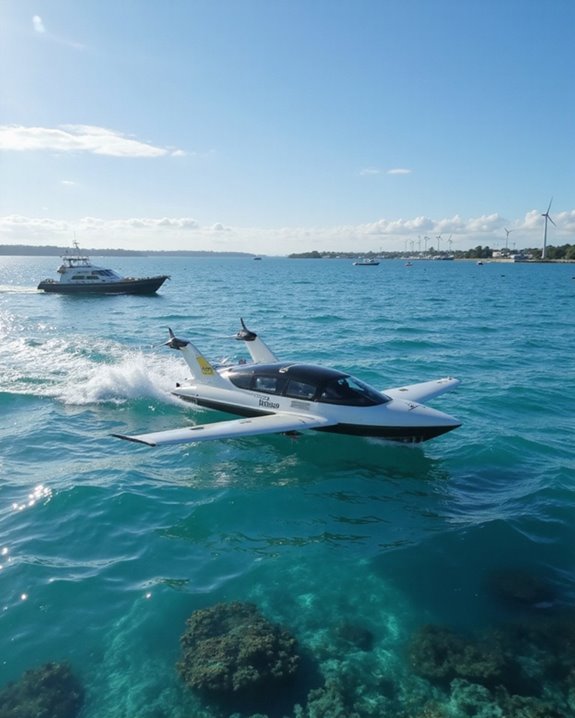
The marine drone industry is making some serious waves—both literally and financially! Right now, this market is worth $4.4 billion, and projections show it could skyrocket to $15.4 billion by 2031. Some even suggest a whopping $22.9 billion by 2034. That’s a lot of underwater robots! Market Expansion is fueled by rising demand for maritime surveillance, environmental monitoring, and resource exploration. With new tech like smarter sensors, longer battery life, and advanced AI, marine drones are getting better every year. These advancements open up exciting Investment Opportunities, especially as industries like shipping, oil & gas, and fisheries rely more on these handy machines. North America leads the pack, but Asia-Pacific and the Middle East are catching up fast, making this sector a global race.
Regulatory Support and Frameworks for Marine Drone Operations
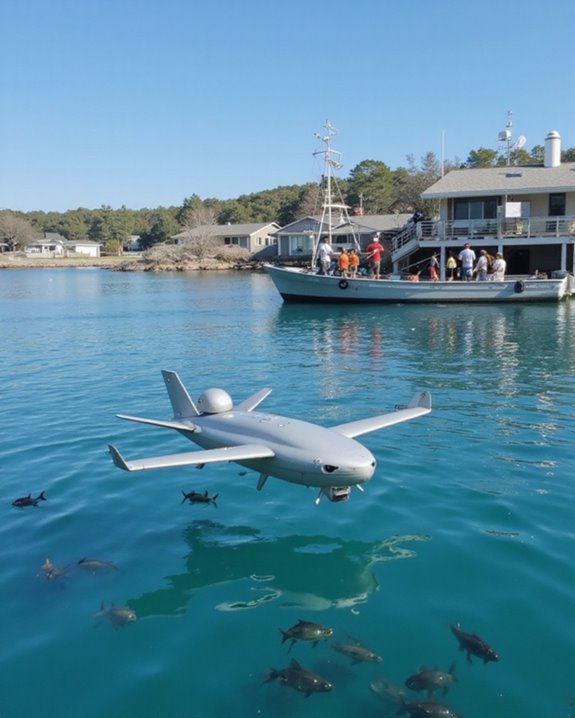
So, the marine drone industry is booming, but all those smart machines need rules to play by—otherwise, it’s chaos at sea! Maritime Policies and Drone Legislation set the stage for safe, fair operations. The International Maritime Organization shapes global standards, but when it comes to drones, many details—like flag state laws—still need tightening. Aviation authorities also step in, making sure drones follow rules like staying under 400 feet, keeping Visual Line of Sight, and using Remote ID for safety. Environmental regulations guarantee drones don’t turn oceans into a wild west. Pilots need training and certification, much like their land-based counterparts, and must stay sharp with ongoing education. Plus, there’s a web of data protection, privacy rules, and liability laws—so everyone’s covered, even if a wave rocks the boat! Additionally, incorporating FAA compliant remote ID modules enhances safety by enabling precise drone tracking and regulatory adherence during operations.
Enhancing Maritime Security With Drones

Imagine spotting trouble miles out at sea—well, that’s exactly what maritime drones are designed for! These high-tech helpers bring a new level of security, making Piracy Prevention and Smuggling Detection much more effective. Thanks to their advanced sensors like LiDAR and radar, drones can quickly spot suspicious vessels and send real-time data back to security teams. With their ability to cover huge areas, drones make border patrol almost look easy, even when geopolitical tensions rise. Their AI-powered brains help them analyze patterns and unusual behavior, reducing the risk of pirates or smugglers slipping through. Plus, drones are a cost-effective solution, saving both fuel and headaches! The U.S. leads the pack, with companies like Northrop Grumman providing top-tier surveillance drones for military and law enforcement. Many of these drones utilize LiDAR technology to maintain performance in low-light conditions, ensuring consistent monitoring regardless of environmental challenges.
Environmental Surveillance and Monitoring Applications
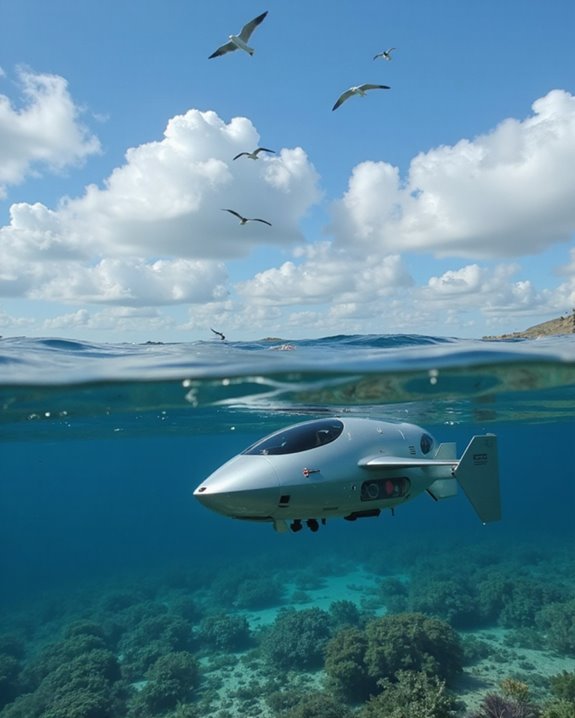
Keeping the seas safe from pirates is impressive, but wait until you see what marine drones can do for the environment! These high-tech helpers zoom across the waves, measuring water quality—think temperature, pH, and oxygen—to keep tabs on ecosystem health. With chemical sensors and multispectral cameras, drones detect pollution events before they become disasters, and they gather long-term data for climate change studies. For biodiversity assessment, drones quietly track whales, dolphins, and seabirds, counting individuals and mapping migration routes without disturbing them. Underwater drones (ROVs) even sneak into tough spots like coral reefs, creating detailed 3D maps. They spot early signs of coral bleaching, monitor seagrass beds, and even catch illegal fishing in the act. It’s like having superheroes under the sea!
Emergency Response and Search and Rescue Missions

How do you find someone lost at sea when the ocean seems endless? Marine drones are changing the game! With rapid deployment and aerial views, drones help emergency teams spot people in trouble faster than ever. These high-tech helpers can cover huge areas in minutes, making them essential for search and rescue missions. Thanks to AI and machine learning, drones can even make quick decisions, flying through rough weather or complex terrains—like digital superheroes! Disaster training now includes drone operation, so responders are ready for anything. Drones also offer psychological support: knowing help is on the way, people feel less alone. Plus, drones keep rescuers safe by surveying dangerous spots from above. Even the best lifeguards need a little tech backup sometimes!
Economic Advantages and Operational Efficiency
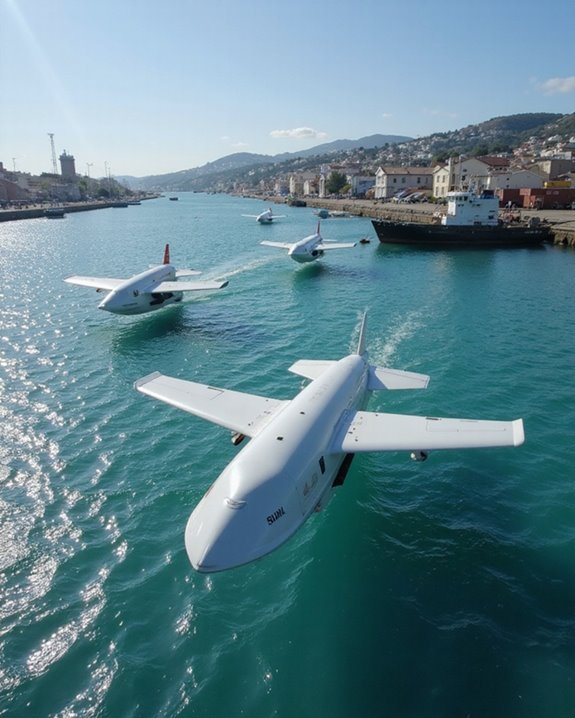
The numbers don’t lie—marine drones are making waves in the global economy! With the marine drone market valued at a whopping USD 4.4 billion in 2023 and set to soar to USD 15.4 billion by 2031, it’s clear these high-tech helpers mean business. Companies love the impressive Investment Returns, since drones slash costs by replacing pricey manned ships for inspections and data gathering. Maintenance Reduction is another win—drones use less fuel, require fewer repairs, and skip the drama of crew logistics. North America is leading the pack, but Asia-Pacific and the Middle East are catching up fast. Whether it’s for oil rig inspections or environmental monitoring, marine drones deliver operational efficiency, letting businesses monitor more frequently and boost profits—without getting their feet wet!
Overcoming Technical Challenges in Marine Drone Deployment

Ever wondered what it really takes to get marine drones out on the water and working smoothly? It’s not just about launching a fancy robot and hoping for the best! Marine drones face some major technical challenges, like battery life—these gadgets need serious juice to stay operational during long missions. Integration hurdles are another big deal. Connecting new drones with existing military systems is no walk in the park; it’s like trying to sync your grandma’s old radio with a modern smartphone! Engineers also have to worry about data security, collision avoidance, and making sure drones can team up with crewed aircraft without causing chaos. Weather resistance and reliable satellite communication just add to the puzzle, demanding constant innovation and clever solutions.
Innovations and Future Trends in Marine Drone Technology
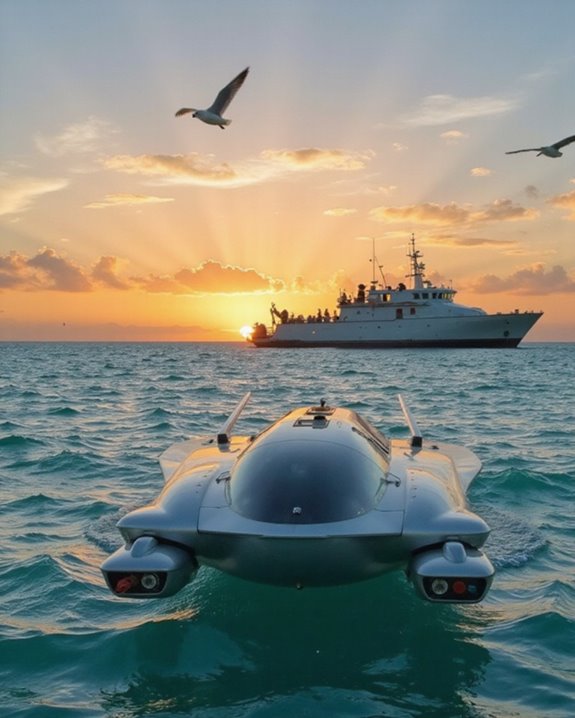
Imagine stepping into a world where marine drones aren’t just tools—they’re high-tech explorers, constantly getting smarter and tougher! Today’s innovations, like the ProteusDrone with its flexible, shape-shifting body, make these underwater robots nimble enough for twisty seafloor adventures. Materials scientists are crafting tougher shells, so drones can dive deep—think MEDUSA reaching 10 meters—without springing a leak. Swarm technology lets drones team up, covering miles of ocean together like a synchronized swimming club. Smart sensors and AI help drones track water quality, map the seafloor, and even spy on marine life in real time. But with all this tech, Drone Ethics matter more than ever. Virtual Simulations now train operators, helping them make safe, eco-friendly choices before sending drones into the wild blue!
Frequently Asked Questions
Can Marine Drones Operate in International Waters Without Restrictions?
Marine drones may generally operate in international waters; however, International Laws and Jurisdictional Limits still apply. Activities such as scientific research or military surveys can trigger legal requirements or restrictions, especially near Exclusive Economic Zones or disputed boundaries.
How Are Marine Drone Operators Trained and Certified?
Operator training for marine drone operators involves structured education on aeronautical knowledge, navigation, and emergency procedures. Certification standards require passing a knowledge test, physical and mental fitness assessments, background checks, and ongoing recurrent training to guarantee regulatory compliance and operational competency.
What Is the Environmental Impact of Drone Manufacturing and Disposal?
Like a rising tide, drone manufacturing and disposal swell environmental concerns through greenhouse gas emissions, resource depletion, and e-waste. Adoption of eco friendly materials and improved waste recycling practices could help mitigate these significant ecological impacts.
Are Marine Drones Susceptible to Hacking or Cyberattacks?
Marine drones are susceptible to hacking or cyberattacks due to their reliance on advanced ICT systems. Conducting regular vulnerability assessment and implementing hacking prevention measures remain essential strategies to reduce cyber risks and secure these autonomous maritime assets.
How Are Privacy Concerns Addressed When Using Drones in Populated Coastal Areas?
While critics argue regulations are insufficient, privacy concerns in populated coastal areas are addressed through Privacy Regulations, Ethical Frameworks, consent requirements, restricted flight zones, data encryption, and public education, ensuring responsible drone use and safeguarding individual privacy rights.


